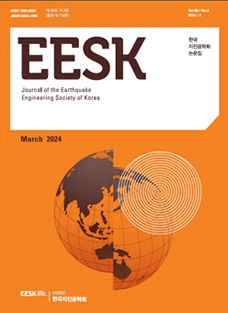1.Introduction
The seismic isolation technology reached its maturity and started to be used extensively in structures like buildings and bridges after 1970s[1,2] and has recently been studied for application in special structures like nuclear power plant structures[3-6]. Seismic isolation has been already applied in nuclear facilities like the Cruas nuclear power plant in France and the Koeberg nuclear power station in South Africa. It is also under construction at the site of the Cadarache nuclear power plant in France[7]. The seismic design of seismically isolated nuclear facilities necessitates imperatively the consideration of not only the nonlinearity of the members like the seismic isolation but also of the soil-structure interaction (SSI)[8-10].
Besides, various studies compared the SSI effect and fixed-base analysis results of seismically isolated structures[11-17]. All these previous studies reported that the response of the superstructure computed by considering the SSI effect was larger than that obtained under fixed-base condition. On the other hand, for the computed displacement response of the nonlinear elements including the seismic isolation, several studies found out fixed-base response larger than the SSI response [13] while other studies concluded the contrary[14,17]. Accordingly, it is necessary to examine precisely the SSI effect on the nonlinear displacement response of the seismic isolation in large and complex seismically isolated structures like nuclear facilities.
The classical approach to solve a nonlinear SSI problem is the hybrid time-domain analysis combining the frequency-domain analysis and the time-domain analysis[18-20]. Recently, a method using concurrently the DRM (Domain Reduction Method)[21] and the PML (Perfectly Matched Layer)[22] has been developed[23,24], and is supported as a function by the LS-DYNA program[25]. Though, it is still realistically difficult to achieve such SSI analysis by means of multi-purposed finite element analysis programs. In practice, the BRM (Boundary Reaction Method) was proposed as an analysis technique avoiding the need of an iterative process for the consideration of the nonlinear SSI effect[26-29]. This method can be exploited for the nonlinear SSI analysis of seismically isolated nuclear facilities by combining both linear SSI analysis in the frequency-domain and time-domain finite element analysis enabling to perform nonlinear analysis.
The level of the design seismic load for the current standard nuclear power plant of Korea corresponds to a peak ground acceleration (PGA) of 0.3g but should be augmented to 0.5g for zones with high seismic risks[30]. However, such increase of the PGA requires tremendous efforts and time since the seismic design of the Korean standard NPP model should be completely revised. Accordingly, research is also actively conducted in Korea on an alternative applying seismic isolation in the nuclear reactor so as to reduce the effective seismic load transmitted to the nuclear structures and to secure their seismic safety[31].
This study intends to evaluate the conservativeness of the fixed-base analysis as compared to the SSI analysis for the seismically isolated model of a nuclear power plant. For this purpose, the nonlinear seismic response of a seismically isolated NPP under fixed-base condition is compared to the one considering the SSI effect. BRM is applied for the SSI analysis considering the nonlinearity of the seismic isolation. Since the reliability of the linear analysis model should be secured in order to achieve exact nonlinear SSI analysis using BRM, the response obtained by BRM for a linear analysis problem assuming the seismic isolation as an equivalent linear model is verified through comparison with the response obtained by the common seismic analysis. After verification of the linear model, nonlinear SSI analysis using BRM is performed and the corresponding results are compared to those of the fixed-base analysis.
2.Analysis model
2.1.Numerical model of seismically isolated NPP structures
This study adopted a seismically isolated NPP model developed for research purpose by Kim and Lee [32] as shown in Fig. 1(b) which is a simplified model of Fig. 1(a) by Han et al.[30]. The properties of the NPP model are given in Table 1. The bottom of a basemat is fixed and the results of the eigenvalue analysis are summarized in Table 2. The element of the seismic isolation (Lead Rubber Bearing, LRB) are simplified by 9 equivalent elements with the previous properties as shown in Fig. 2.
2.2.Input earthquake
The design response spectrum for the horizontal earthquake input motion at the ground surface of the free-field soil adopts the RG 1.60 design spectrum with the acceleration component at natural frequency of 25 Hz augmented by 30% and the ZPA (Zero Period Acceleration) extended from 33 Hz to 40 Hz as shown in Fig. 3(a). The acceleration time history for the seismic analysis is shown in Fig. 3(b) as provided by KEPCO E&C so as to include the design response spectrum. In addition, the displacement time history plotted in Fig. 3(c) is obtained by integrating twice the acceleration time history of Fig. 3(b). The PGAs of the input earthquakes used in the nonlinear SSI analysis and fixed-base analysis are 0.1 g, 0.2 g, 0.3 g, 0.4 g, and 0.5 g by scaling the input motion given in Fig. 3.
2.3.Soil conditions
The soil conditions adopted for the nonlinear SSI analysis using BRM are three of soil profiles taken from Han et al.[30] and names as SC1, SC2, and SC3. The properties down to the depth of 61 m (200 ft) are used for each soil in the nonlinear SSI analysis. Figs. 4 to 6 present the respective properties of the SC1, SC2, and SC3 soil profiles.
Soil profile SC1 has a shear wave velocity of 548.8 to 1862.3 m/s down to the depth of 61 m, and is the softest among the three soil profiles with a velocity of 1862.3 m/s in the semi-infinite layer. Soil profile SC2 has a shear wave velocity of 548.9 to 2804.2 m/s down to the depth of 61 m with a velocity of 2804.2 m/s in the semi-infinite layer. Soil profile SC3 has a shear wave velocity of 1437.1 to 2804.2 m/s down to the depth of 61 m with a velocity of 2804.2 m/s in the semi-infinite layer.
3.Nonlinear SSI analysis and fixed-base analysis
3.1.Application procedure of BRM for nonlinear SSI analysis
The concept of BRM subdivides the nonlinear SSI analysis problem of the seismically isolated nuclear structure shown in Fig. 7(a) into two substructures (I) and (II), and superposes substructure (I) shown in Fig. 7(b) in which the base of the seismic isolation is fixed and substructure (II) shown in Fig. 7(c). Here, substructure (I) constitutes the linear SSI problem while substructure (II) represents the nonlinear problem. Thus, the total solution ut(t) can be obtained by simple summation as
where the superscripts (I) and (II) stand for the substructure (I) and the substructure (II) respectively; and the motions within the nonlinear body in the substructure (I) are zero, i.e.
Thus responses in the nonlinear region ‘i’ and the boundary ‘b’ are the same as those in the substructure (II), as follows
With this superposition, the nonlinear restoring forces in the nonlinear region ‘i’ and the boundary ‘b’ are also the same as those in the substructure (II). More detailed theoretical background are given in Reference 29.
In substructure (I) of BRM, the reactions at the interface are computed considering the dynamic characteristics of the soil by performing conventional linear SSI analysis and fixing the lower part of the seismic isolation. For this part, the linear SSI analysis program in the frequency-domain, KIESSI-3D, is applied[33,34]. Substructure (II) of BRM refers to the analysis step of the wave radiation problem which performs forced vibration analysis by applying the interfacial reactions computed at the base of the seismic isolation of substructure (I) in the opposite direction. Here, the multi-purpose finite element analysis program MIDAS/Civil[35] is used since it can take into account the nonlinearity of the seismic isolation.
In substructure (II) of BRM, need is for a program enabling to deal with the interface by means of a type of energy-absorbing boundary condition that is the PML element or damper-spring element within the analysis domain for the efficient treatment of the radial damping occurring in the SSI[27]. In this study, the boundary is modeled using damper-spring elements. The coefficients for the spring element and the viscous damper element at the boundary proposed by Deek and Randolph [36], Kellezi[37], and Liu[38] are adopted. The spring coefficient KBN and damping coefficient CBN in the normal direction per unit area at the boundary are computed using Eq. (4) and, the spring coefficient KBT and damping coefficient CBT in the tangent direction are calculated using Eq. (5).
where r is the radial distance from the center of the foundation to the boundary; ρ is the mass density of the far field soil; Vp is the compression wave velocity in the far field soil; and, Vs is the shear wave velocity in the far field soil.
3.2.Establishment and verification of BRM analysis model
The nonlinearity of the seismic isolation and the soil-structure interaction should be considered for the nonlinear SSI analysis of seismically isolated nuclear facilities. The nonlinear behavior of the seismic isolation can easily be considered using a finite element program in the time domain. Therefore, the accuracy of a nonlinear SSI analysis depends on the accuracy of the boundary reaction forces calculating in frequency and a suitable numerical model for the wave radiation problem in the time domain. In order to evaluate reaction forces and the numerical model for the BRM analysis, equivalent linear time history analysis is performed and the structural responses are compared with those obtained by ordinary seismic analysis using KIESSI-3D. The analysis models for the analysis using KIESSI-3D and MIDAS/Civil are illustrated in Fig. 8. The models are prepared to meet wave passage criteria, i.e., , where h is the largest size of the finite element mesh; Vs is the smallest value of shear wave velocity of soil(=548.8 m/s); fmax is maximum frequency of interest (=12 Hz). The dashpot and spring elements are placed on the truncated FE model depicted in Fig. 8(b) in accordance to method described in the Section 3.1 to absorb the radiating elastic waves.
The seismic isolation of the equivalent linear analysis applies an effective stiffness keff and its damping is modeled by means of the viscous damping coefficient. The damping ratio ξBI = 0.28 is applied to compute the viscous damping coefficient cBI using Eq. (6).
where ξBI is the critical damping ratio of the base isolator; keff is the effective stiffness of the seismic base isolation (Fig. 2); and, m = 5.171×104 ton is the mass of the superstructure for one base isolation.
The reactions at the boundary applied as effective loads in substructure (II) of BRM are calculated using KIESSI-3D for the soil profiles SC1, SC2 and SC3 at the 9 spots at the base of the base isolators (BI) shown in Fig. 9. Fig. 10 plots the reactions at BI of Fig. 9.
The time-domain analysis using MIDAS/Civil operates by the direct integration method. Here, the damping ratio of the structure and soil at the exception of the base isolation is the Rayleigh damping, that is [C] =α[M]+β[K]. For the calculation of the Rayleigh damping of the structures, a damping proportional to the stiffness by a constant of proportionality β is applied giving a damping ratio of 0.05 at 3.67 Hz for the containment building, 0.07 at 6.33 Hz for the auxiliary building, and 0.07 at 9.56 Hz for the internal structure. Frequencies of 0.4 Hz and 10.0 Hz are applied for the calculation of the Rayleigh damping of the soil, and particular damping ratio is adopted for each soil profile. The structural response of the equivalent linear analysis in the frequencydomain using KIESSI-3D is used as solution of reference. Identically to BRM analysis, the analysis using KIESSI-3D applies the Rayleigh damping for the structures and soil, and adopts viscous damping for the seismic base isolation.
In this study, calibration of the boundary reactions was conducted for the equivalent linear problem prior to the time-domain nonlinear analysis by BRM (Fig. 11). The scale factor for the boundary reactions was determined with reference to the response spectrum of the superstructure obtained by the frequency-domain SSI analysis at the frequency of the base isolation (0.40 Hz in this example).
Fig. 12 compares the horizontal response spectra at the top of the containment building obtained by equivalent linear analysis by BRM and by equivalent linear SSI analysis in frequency-domain. The reliability of the BRM numerical model for the nonlinear analysis can be verified through the good agreement between the linear analysis results by BRM and the linear SSI analysis results in the frequency domain for each of the considered soil profiles.
3.3.Comparison of responses by nonlinear SSI analysis and fixed-base analysis
Nonlinear SSI analysis using BRM and nonlinear time history analysis assuming a fixed-base without consideration of the soil profile were carried out for the seismically isolated structure. The BRM analysis model for the nonlinear SSI analysis is identical to the linear analysis model except for the nonlinear elements of the base isolation. The fixed-base analysis model corresponds to the simplified model of the seismically isolated NPP model in Fig. 1(b) in which the base is fixed.
In a seismically isolated structure, the seismic load acting on the structure generally reduces but the displacement of the superstructure augments. This implies that the displacement of the base isolation constitutes an important design variable. In this study, the response at the top of the structure and the peak displacement of the base isolation are computed with respect to the PGA of the input control motion by means of the nonlinear SSI analysis using BRM and the fixed-base analysis.
Fig. 13 compares the horizontal acceleration response spectra with the results of the fixed-base analysis according to the soil conditions of BRM. Figs. 14 to 16 plot the nonlinear hysteresis curves of the base isolation. Table 3 arranges the peak displacements of the base isolator obtained by means of the two types of analysis.
In Fig. 13, it can be seen that, for soil profile S9 with the closest soil condition to the fixed-base, the responses at the top of the structure given by both types of analysis are very similar when the intensity of the seismic load is relatively small (PGA = 0.1 g and 0.3 g). However, the comparison of the spectral acceleration response given by the fixed-base analysis to that given by the nonlinear SSI analysis in case of strong seismic load (PGA = 0.5 g) with damping ratio of 5% in Fig. 13(c) reveals that there is very minimal difference at natural frequency of about 0.4 Hz for the seismic isolation whereas the response becomes smaller by approximately 10.0% at natural frequency of about 3.0 Hz for the superstructure.
Besides, for the soil profiles SC1 and SC2, it appears in Fig. 13(a) and 13(b) that the fixed-base response is very close to the SSI response at the natural frequency of the base isolation whereas the spectral acceleration response exhibits clear difference at the natural frequency of the superstructure and at frequency range higher than 2 Hz and that this difference accentuates with larger intensity of the seismic input. On the whole, it can be observed that the fixed-base response is smaller than the SSI response.
Fig. 17 compares the peak displacement of the base isolator according to the eventual consideration of SSI and the intensity of the seismic input load. It can be observed that the peak displacement of the base isolator provided by the fixed-base analysis is similar or slightly larger than that given by the nonlinear SSI analysis.
4.Conclusions
In a will to evaluate the conservativeness of the fixed-base analysis as compared to the soil-structure interaction (SSI) analysis for a base-isolated model, this study conducted nonlinear SSI analysis using BRM (Boundary Reaction Method) and fixed-base analysis on a seismically isolated model of a nuclear power plant. The reliability of BRM was secured through the verification of the numerical model with an equivalent linear base isolation model. Nonlinear SSI analysis was performed considering 3 types of soil profile and 5 different intensities of the seismic load. The response at the top of the structure and the peak deformation of the base isolation obtained by the nonlinear SSI analysis and the fixed-base analysis were compared for each considered analysis condition. The following conclusions can be drawn from the analysis results.
-
In view of the nonlinear displacement of the base isolation, the response provided by the fixed-base condition appeared to be larger and the difference tended to accentuate with higher intensity of the input ground motion. It can thus be stated that the analysis results for the seismically isolated structure assuming fixed base lead to conservative computation of the design displacement of the base isolation in the seismically isolated nuclear facilities.
-
With regard to the floor response spectrum of the superstructure, both fixed-base condition and SSI condition were seen to provide similar results in case of hard soil and small input motion but the difference in the response increased with higher intensity of the input ground motion and softer soil. Moreover, the floor response spectrum under fixed-base condition was smaller than that under SSI condition.
Finally, further studies incorporating actual ground accelerations are recommended to enhance the above conclusions.





























